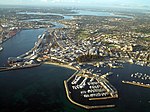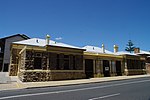St John's Anglican Church, Fremantle
1843 establishments in Australia19th-century Anglican church buildings in AustraliaAnglican Diocese of PerthAnglican church buildings in Perth, Western AustraliaAnglo-Catholic churches in Australia ... and 11 more
Churches completed in 1843Churches completed in 1882Churches in FremantleDonnybrook stone buildingsHigh Street, FremantleState Register of Heritage Places in the City of FremantleStone churches in AustraliaUse Australian English from August 2013Victorian architecture in Western AustraliaVictorian church buildings in AustraliaWestern Australian places listed on the defunct Register of the National Estate

St John's Anglican Church also known as St John the Evangelist Church, is the historic Anglican parish church of Fremantle, Western Australia. The first Georgian-style church close to the present site was opened in 1843, and then replaced with a larger Gothic building nearby in 1882. The older building was demolished, which allowed Fremantle Town Hall to be built and for the High Street to be extended, giving the Kings Square its current shape. The church is part of the Anglican Diocese of Perth, and currently forms a parish jointly with St. Peter's in Palmyra.
Excerpt from the Wikipedia article St John's Anglican Church, Fremantle (License: CC BY-SA 3.0, Authors, Images).St John's Anglican Church, Fremantle
Adelaide Street,
Geographical coordinates (GPS) Address Website External links Nearby Places Show on map
Geographical coordinates (GPS)
| Latitude | Longitude |
|---|---|
| N -32.053611111111 ° | E 115.74805555556 ° |
Address
Saint John's Anglican Church (Saint John the Evangelist Church)
Adelaide Street 3
6160
Western Australia, Australia
Open on Google Maps











